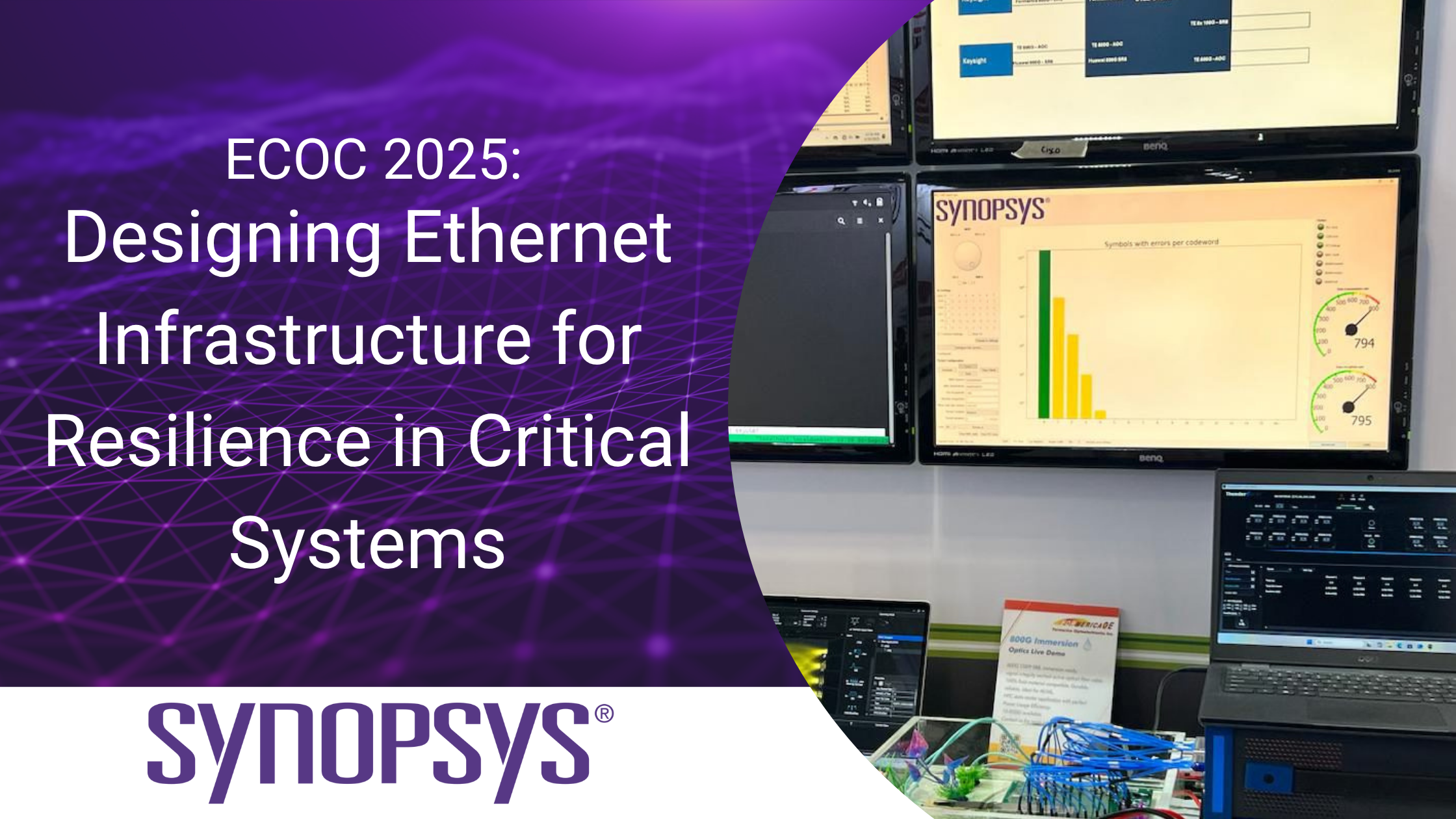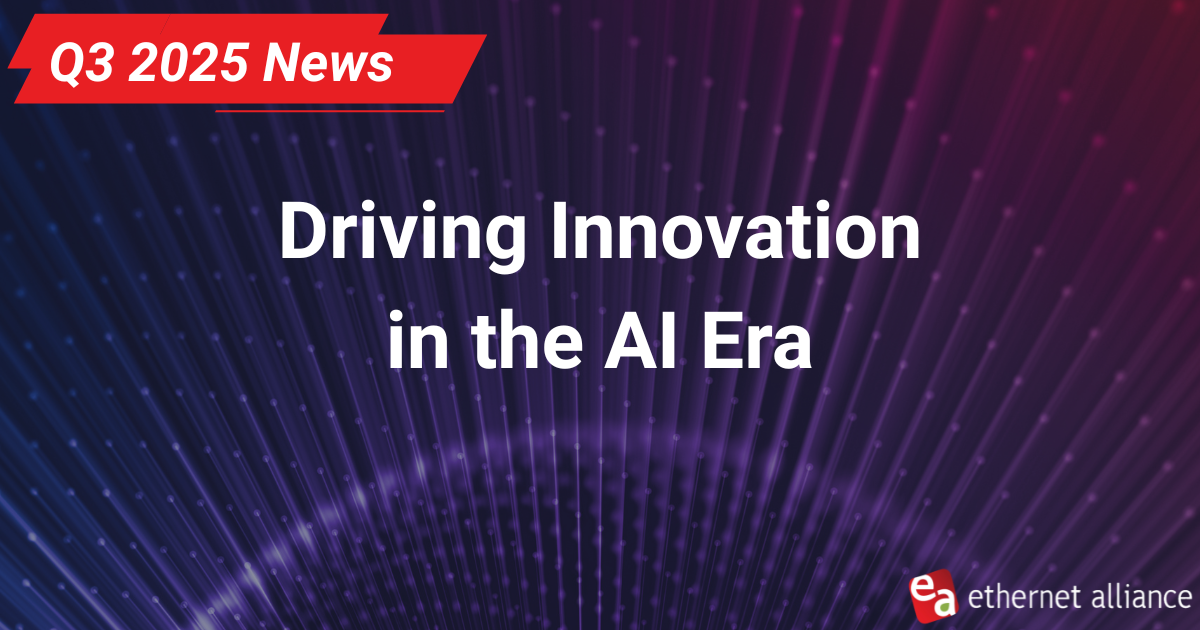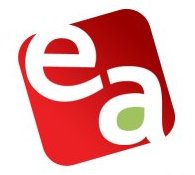Beyond the Demo: What OFC 2025 Revealed About the Future of Ethernet
At OFC 2025 in San Francisco, the Ethernet Alliance delivered one of its most popular interoperability demonstrations to-date, showcasing Ethernet’s ongoing evolution in speed, efficiency, and performance.
One of the industry’s most important gatherings, OFC offers unparalleled opportunities to observe, explore, and discuss emerging trends and challenges shaping the Ethernet ecosystem. Ethernet Alliance President and Events and Conferences Chair, David J. Rodgers of EXFO and, and Ethernet Alliance Chairman, Peter Jones of Cisco, share their unique perspectives and key takeaways from this year’s event.
What are the most important trends you saw during OFC 2025?

David J. Rodgers: One of the most prominent trends at OFC 2025 was the growing momentum behind 200G/lane and 1.6T Ethernet. AI is driving the “need for speed”, fueling demand for high-speed, high-performance products, services and infrastructure solutions.
Peter Jones: I would say that AI dominated the conversation, with the industry focused on how to best respond to rapidly changing demands from key customers. We saw this reflected in technology demos featuring 448G solutions, liquid cooling, and evolving module design, particularly around the future of form factors like CPO and CPC.
With AI causing unprecedented demand for speed and scale, how is it transforming the Ethernet ecosystem?
David J. Rodgers: The AI boom is turning Ethernet’s evolution into a very physical challenge…and data centers are feeling the burn. Higher speeds bring increased power consumption and heat. Data center operators must rethink how they deploy and cool equipment, which is why we’re seeing a turn toward liquid enhanced cooling solutions.
Peter Jones: The rapid scale-up of AI deployments is putting pressure on global supply chains. As demand for networking hardware, computing systems, and critical infrastructure components skyrockets, sourcing the materials needed just to make these products is becoming trickier.
What stood out to you the most at OFC 2025, and why?
David J. Rodgers: That 800G is truly here and 1.6T is just over the horizon. The Ethernet Alliance interoperability demo put fully mature 800G interconnects and solutions on display. If you need more proof, consider the significant progress on Linear Pluggable Optics (LPO), which went from concept to a ratification specification in the space of a year. Yes, I’d say that 800G has definitely arrived.
Peter Jones: I think one key takeaway from OFC 2025 is the expectation that the industry will deliver increasingly advanced technology at breakneck speed, even while confronting some very complex challenges. As I like to say, “Physics is hard!”
What were the most intriguing conversations you overheard at OFC?

David J. Rodgers: Among the most interesting things is the sense of urgency around reducing operating expenses and environmental impacts, especially with 800G deployments on the rise. There’s mounting concern – and rightly so – about AI and hyperscale data centers’ insatiable energy appetites. Already, they’re drawing as much power as some major U.S. cities. There’s intense discussion about how we produce energy, and just as critically, how to dissipate the heat it generates. As 1.6T Ethernet gets closer, finding workable solutions to these problems today is essential to enabling the higher-speed infrastructure of tomorrow.
Peter Jones: I spoke with and listened to more investment analysts at the Ethernet Alliance booth than ever before. Trust me when I say that Wall Street is paying very close attention to what’s happening in Ethernet innovation.
What are the biggest hurdles facing the industry and what game-changing solutions caught your eye at OFC?

David J. Rodgers: Thermal management is atop the list and we saw lots of innovative approaches like cold plates, refrigerated racks, and immersion cooling being showcased.
Cold plates stood out for their retrofit potential, as swapping out traditional heatsinks for refrigerant-cooled plates offers a relatively simple upgrade path. Then there were full-rack enclosures that essentially function like data center-sized refrigerators. Looking further ahead, immersion cooling is gaining serious traction among unexpected sectors like petrochemicals and automotive suppliers. That cross-industry momentum signals a shift toward more scalable, long-term solutions for heat and power efficiency.
Peter Jones: Where do I start? We keep hearing, “I need it faster, better, cheaper, and I need it NOW!” There’s a clear expectation that the pace of innovation will keep accelerating but no one has all the answers yet. We’re not quite sure what’s in the “magic happens here” box. A lot of what we saw at OFC were building blocks, not blueprints, but that’s how real progress begins.
How is the Ethernet Alliance helping to usher in the next wave of Ethernet innovation?
David J. Rodgers: The Ethernet Alliance is a catalyst for progress. Our mission centers on accelerating innovation, and we’re actively leading the discussion about what comes next. During the last 12 months, we hosted our latest Technology Exploration Forum, and multiple workshops and plugfests that brought AI discussions to the forefront, advanced the interoperability of LPO modules, and even tested early 1.6T products. It’s all about turning bright ideas into practical, working technologies.
Peter Jones: Ethernet Alliance occupies a unique position in that we advocate for the whole of the Ethernet ecosystem. This gives us both the platform and the responsibility to help build cross-industry consensus, because there’s not enough time in the day to go chasing every option. As RFC 1925 wisely says, “…perfection has been reached not when there is nothing left to add, but when there is nothing left to take away.” We help the industry focus on what really matters.
What’s the best way for people to roll up their sleeves and get involved with the Ethernet Alliance?

David J. Rodgers: The Ethernet Alliance is powered and empowered by its members, so the first step is simple: join! From hosting interoperability events, to contributing blogs and white papers, to participating in public interoperability demonstrations like the one at OFC 2025, we’re always looking for fresh faces and new ideas to making Ethernet “just work”.
Peter Jones: Reach out, show up and step up. The Ethernet Alliance is all about contribution; you get out of it what you put in. We do three things here:
- We make sure Ethernet “just works” through our plugfests
- We show that Ethernet “just works” with public interoperability demos
- We explain how Ethernet “just works” via expert webinars, blogs, contributed articles, and panel discussions.
Come help us do these things better.




